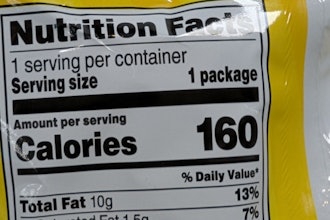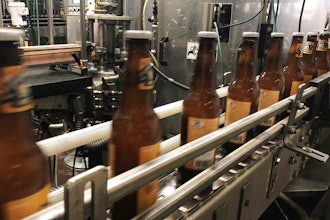
The U.S. Food and Drug Administration (FDA) issued the final rule, "Food Labeling: Nutrient Content Claims; Definition of Term 'Healthy'" to help consumers quickly and easily identify foods that foster healthy eating habits. Manufacturers can voluntarily use the "healthy" claim on food packaging if the product meets the following criteria:
- It contains a certain amount of food from at least one food group or subgroup (fruits, vegetables, etc.) as recommended by the Dietary Guidelines for Americans.
- It adheres to specified saturated fat, sodium, and added sugars limits.
As of February 25, 2025, the effective date for the final rule was delayed until April 28, 2025. Currently, the compliance date of February 25, 2028, remains the same.
On January 14, 2025, the FDA also proposed requiring a front-of-package (FOP) nutrition label for packaged goods. The FOP nutrition label, also referred to as the "Nutrition Info box," gives information on saturated fat, sodium, and added sugars in a simple way—by showing if the food has low, medium, or high levels of these nutrients.
If finalized, this proposed rule would require manufacturers to add the FOP nutrition label to most packaged foods three to four years after its effective date, depending on their annual food sales being more or less than $10 million.
This dual strategy by the FDA supports responsible product marketing and accessible nutritional information to improve consumer decision-making. It also creates an opportunity for food manufacturers to respond to consumer demand for transparency and assess their current labeling infrastructure to ensure it's agile enough to respond to evolving regulations.
When & how to start preparing for food labeling changes
If you haven't started to prepare for the "Food Labeling: Nutrient Content Claims; Definition of Term 'Healthy'" and "Nutrition Info box" rules yet, it's time. Begin by auditing your labeling system to check if it's flexible enough to withstand major or minor changes without disrupting operations, production, and ultimately profitability.
Three questions to ask and help determine if your labeling system is ready for change:
- Are you printing labels in-house and on demand?
- Are your label templates connected to data sources?
- Are you using network licensing, so labeling isn't limited?
If the answer is "no" to any of these questions, let's go through a few ways to easily modernize your labeling infrastructure so it's ready for upcoming and future rules.
Print your product labels in-house and on demand
When you manage your labeling inside your four walls, you have full control over the process and can change things quickly due to regulatory or industry standard changes.
Printing labels as you need them also helps cut down on wasted label stock and saves money in the long run. Instead of having to order excessive minimum quantities, you can print labels on demand to ensure you never have to throw out rolls of pre-ordered labels that become obsolete.
Real-world example of migrating from outsourced to in-house labeling
All Seasonings Ingredients, Inc. leveraged a third-party company to design and print private labeling orders, at a minimum print quantity of 2,500 labels. This process took two-to-three weeks and reprints due to simple design changes to pre-printed product labels meant wasted label stock taking up space in their facility and thousands of dollars lost.
By taking label design in-house and being able to print on demand, they:
- Eliminated pre-printed labels going unused
- Standardized labels for 1,000+ products
- Met product traceability requirements
Connect to multiple data sources with label templates
Using label templates with database connections makes your labeling system resilient to changes within your business or with the food industry and regulating bodies. Since the label data is being accessed in real-time from your business system, it's sure to be up to date, and changes to product information are implemented seamlessly.
Beyond being able to connect your labels to an ERP system, WMS, MES, Access or Excel, or another database to pull information into label templates, you can also automatically collect data at print time from a device, such as a scale or scanner.
Use network licensing so labeling isn't limited to one workstation
You can have more than one user running labeling software at the same time from different workstations, without managing multiple single-user licenses, with network licensing.
Network licenses act as "floating licenses" and are hosted in a centralized location, like a server. The software can be installed on an unlimited number of computers on the same network, and multiple people can be running the software simultaneously, based on the number of network users your license includes. You can have a 3, 5, or 10 network user license, and administrators can remove inactive users to free up a network user license.
If you want to take it a step further towards scalability, consider browser-based label printing. By eliminating client installations altogether and enabling label printing from a browser, you can increase operational efficiency and reduce IT overhead. Browser-based label printing also meets the needs of businesses with multiple locations or partners, such as suppliers or contract manufacturers.
Turn compliance into an opportunity & competitive advantage
Remember, the "Food Labeling: Nutrient Content Claims; Definition of Term 'Healthy'" and "Nutrition Info box" rules create an opportunity for food manufacturers to audit their labeling system and modernize their infrastructure to respond quickly to changes.
Auditing your labeling system regularly helps you make sure you're meeting compliance as regulations evolve, your labeling system is supporting operational efficiency rather than hindering it, and you're able to easily scale as your business and production grows.
Don't wait until the compliance dates—start preparing for these food labeling rules today. By being an early mover and continuously improving your labeling system, you can reduce costs, enhance its agility, and build consumer trust and loyalty.
A labeling system provider is an excellent source of information, guidance, and support while navigating food labeling requirements.























